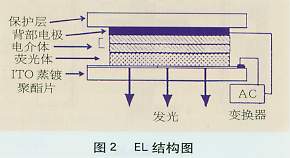(3) EL luminous ink
   EL (Electro Luminescent Light) is a film surface light emitter that uses an inorganic phosphor/dielectric layer sandwiched between electrodes and that changes the electric field of the phosphor and uses the phosphor light emission phenomenon. The structure of the EL is shown in Figure 2.

The substrate on the light-emitting surface side is generally an ITO-deposited polyester film using a transparent conductive film. For the phosphor ink printed on the ITO vapor deposition surface, the same phosphor as the inorganic phosphor represented by the black light emission is used, and the EL phosphor has the property of preventing humidity and reducing the brightness. In order to prevent moisture from penetrating, an encapsulated phosphor is used, and a resin having a good water repellency against moisture barriers is also used to bond the resins.
Dielectric inks are dispersed in high-conductivity ceramic powders. Because of the insulating effect, 2-layer or 3-layer printing is performed. The back electrode generally uses a carbon paste that is a conductive ink, and a silver paste is used when a large light emitting area is encountered. A silver paste is used as a bus line printed on the ITO vapor deposition surface along the phosphor surface. The protective layer is good in both insulation and water resistance, and is printed with a UV-curable insulating ink that forms a strong film, or is laminated with a protective film. An example of a printing project is shown in FIG.

Power supplies typically use 80 to 120 V, AC/400 Hz converters. Although the high voltage and high frequency can increase the brightness, it will reduce the life of the EL lamp. At the same time, the use of high temperature or high humidity environment will reduce the life of the EL lamp.
EL lamps are mostly used in LCD backlights. Others include surface displays such as displays, billboards, and posters.
2. Heat and stress effects
(1) Insert molding
   The surface shape of the membrane switch adopts the insert molding method (see Fig. 4). After the printed diaphragm is assembled into the steel mold, the molded resin is injected together with the diaphragm to form an integrated molded product. In order to integrate the dissimilar resin of the diaphragm and the molding resin, it is important that the adhesive layer adhered to the film surface. As the ink for insert molding, a two-liquid reaction type ink having resistance to heat resistance (180° C. or more and 1 min) of an injection molding resin and flexibility to perform embossing processing is used. The adhesive uses a clear ink that is solubilized in a hot thermoplastic resin.

(2) IMD (Injection Mouldine Decoration)
This is a resin molding method that has recently been rapidly popularized, and is a method of performing injection molding after preforming on a diaphragm. The whole process is printing → pre-forming → trimming → injection molding → product (see Figure 5). As a preforming method, ultra-high pressure molding (a type of pressure forming), vacuum forming, and steel die pressing may be used. After trimming the pre-formed film, it is completed by fusion with the resin in the injection molding machine. Generally speaking, the non-printing surface is the surface of the product, and the decorative surface is made of a sandwich layer and has the advantage of abrasion resistance. The ink used requires the flexibility of deep drawing and the high heat and high pressure resistance that can resist molding. In contrast to these two opposite properties, the ink binder resin uses a polycarbonate or polyester resin having a high glass transition temperature (Tg).

Office Pencil Art Set,72Pcs Sketch Pencil Art Set,72Pcs Sketch Tool Set,6H-12B Sketch Tools Artist Set
Zhoushan Shenglan Trade Co., Ltd.  , https://www.seamiart.com